Nombre:
Castillo de Moszna
Otro: Zamek Moszna
Localización:
View Larger Map
Tipo: Militares
Categoría: Castillos
Foto:
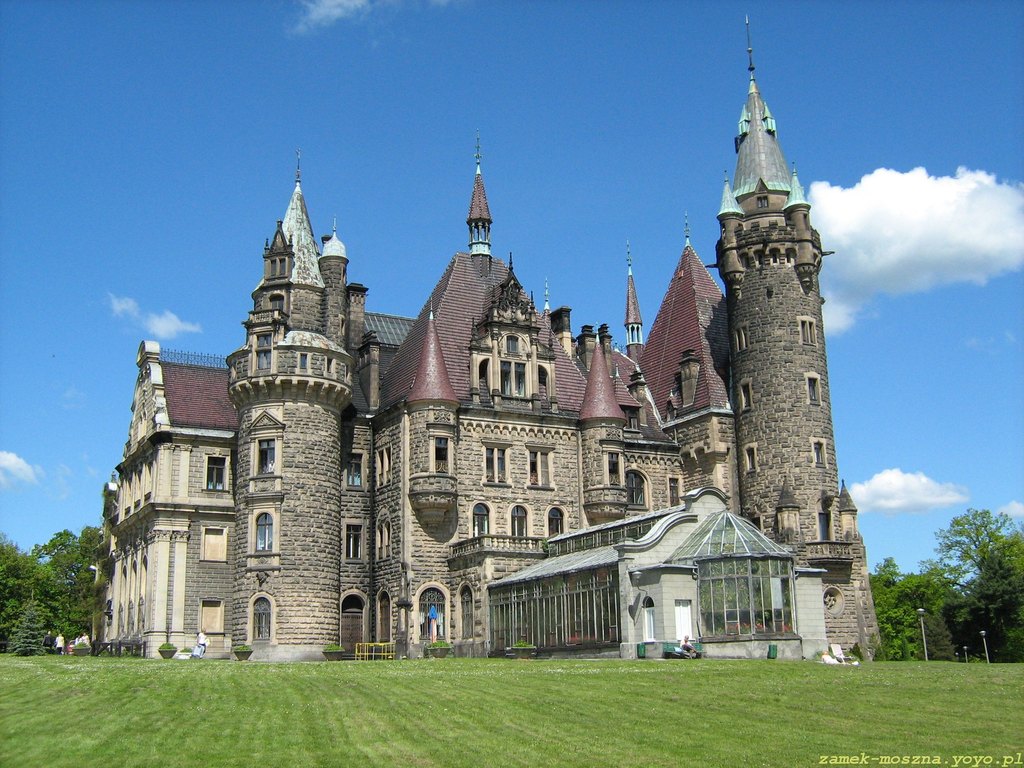
Voto:
Continente: Europa
País: Polonia
Localización: Moszna
Año: s. XVII
Estado: Terminado
Descripción:Un castillo de fábula
Conjunto de parque y palacio, antigua residencia de la familia alemana de los Tiele-Winckler. Los orígenes de la construcción se remontan al siglo XVII. El palacio posee en total 365 habitaciones y 99 torecillas, tiene una superficie de 7.000 m2 y un volumen de 65.000 m3. Recuerda a los castillos ingleses de la época isabelina. Actualmente se ha convertido en hotel. Una de sus mayores atracciones son sus cuadras de caballos de pura sangre inglesa.
Centro Terapéutico de la Neurosis, Moszna; tel. (48-77) 466 84 18, tel./fax 466 84 00; www.moszna-zamek.pl, ctn@moszna-zamek.pl
http://es.polandforall.com/un-castillo-de-fabula-moszna.html

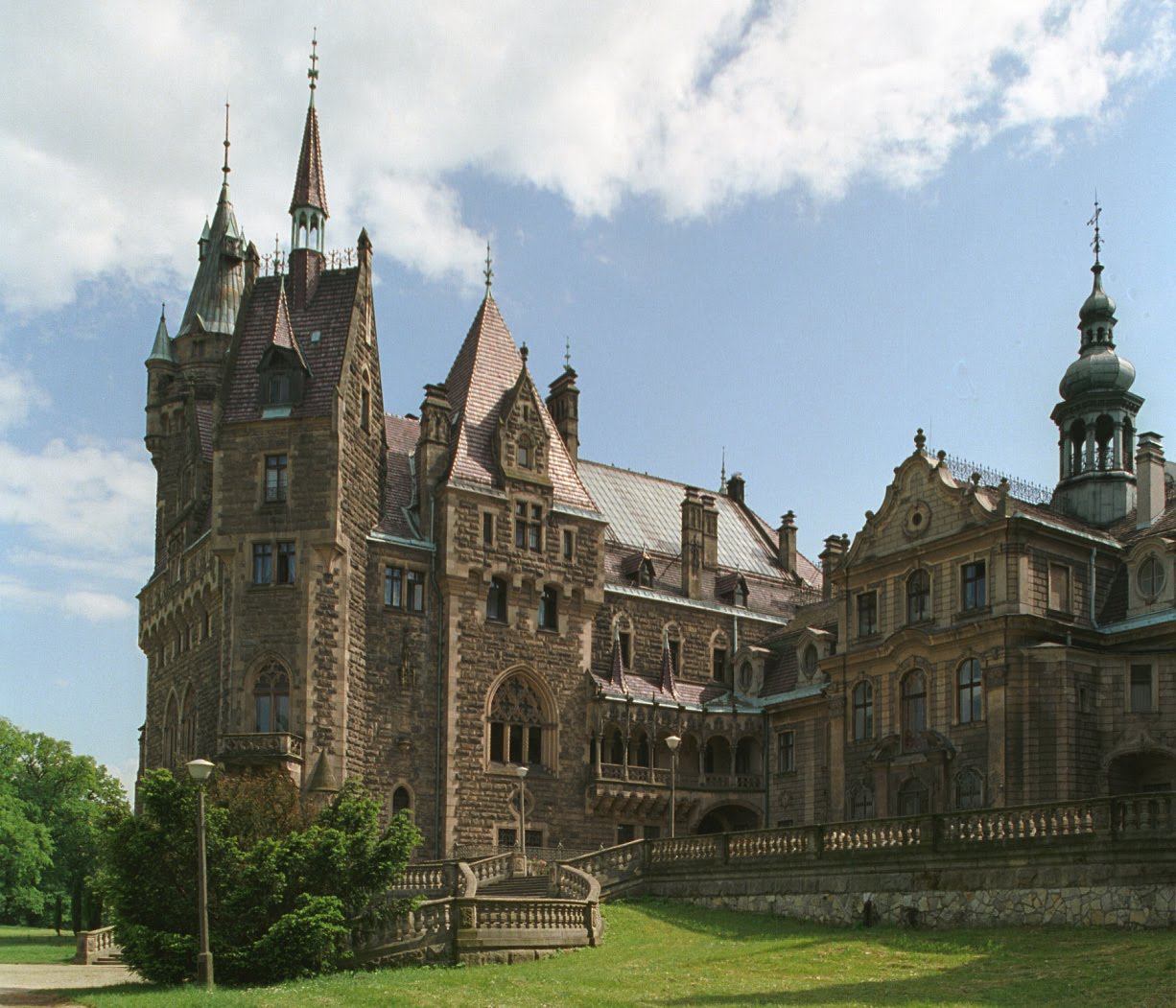

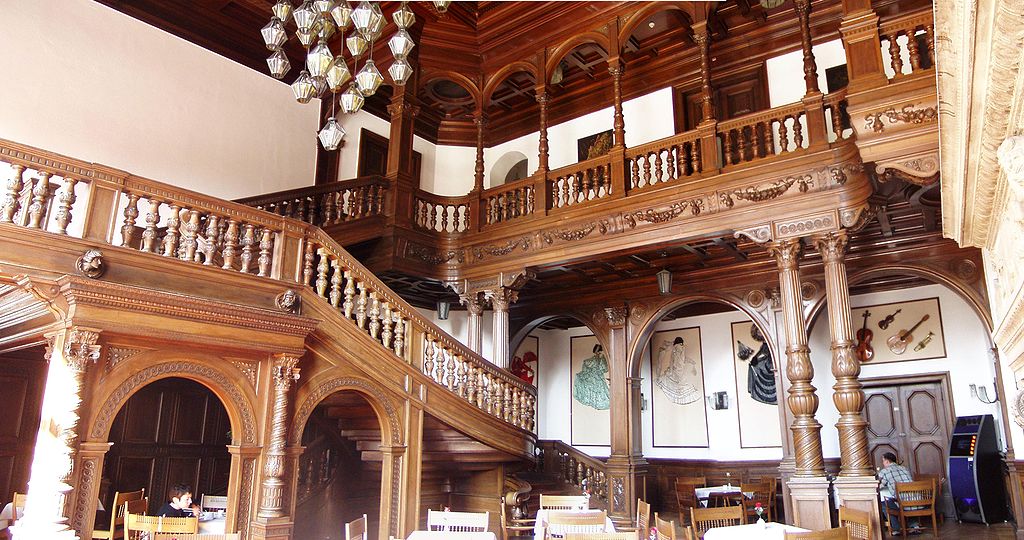
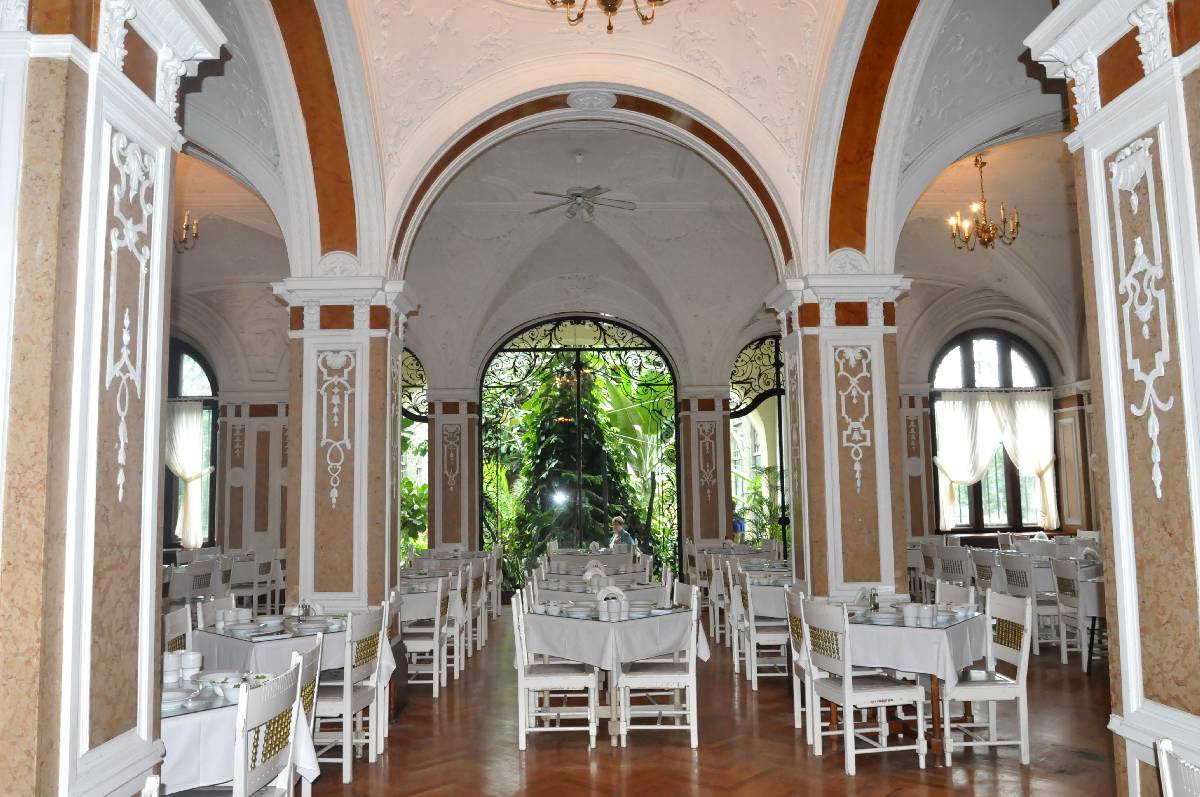
El castillo de Moszna – Polonia (sacado de un cuento de hadas)
Moszna es un pequeño pueblo en el suroeste de Polonia conocido por su castillo, uno de los monumentos más conocidos del país.
La historia de este edificio comienza en la mitad del siglo XVII. Su parte central es un antiguo palacio barroco que fue parcialmente destruido por un incendio en la noche del 2 de junio de 1896 y reconstruido en el mismo año en su forma original.
Hoy el castillo es usado como un Centro de Salud Pública de terapia de neurosis, pero sigue siendo muy visitado por los turistas.
La parte oriental fue construida en estilo neogótico en 1900 junto con la instalación adyacente de invernadero.
El interior cuenta con 365 habitaciones y un total de 7.000 metros cuadrados.
En 1912-1914 se construyó la ala oeste en estilo neorenacentista.
El castillo entero posee 99 torres y su forma arquitectónica con numerosas torres y capiteles dan la impresión de verticalismo.
El castillo también cuenta con una capilla que se utiliza como sala de conciertos. Y desde 1998 el edificio alberga una galería en la que las obras de varios artistas se presentan en exposiciones regulares.
Aparte del castillo, el complejo incluye un parque combinado con campos cercanos, prados y un bosque.
Publicado el 04 de Marzo de 2011 , por Ana Barroso Molina


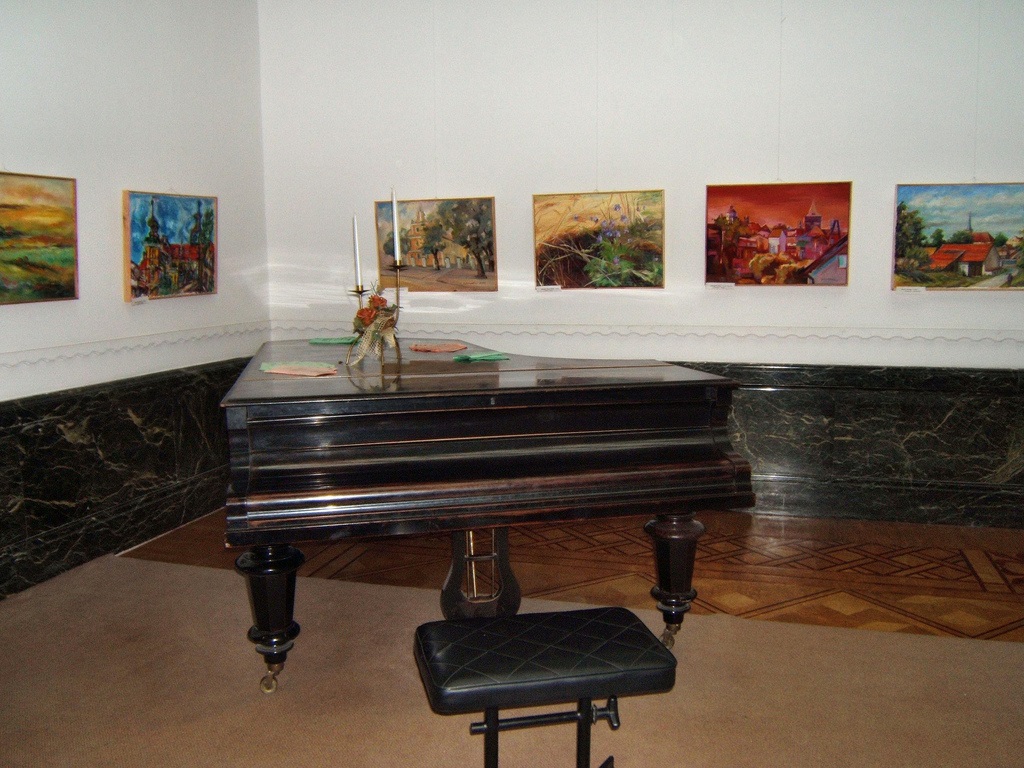

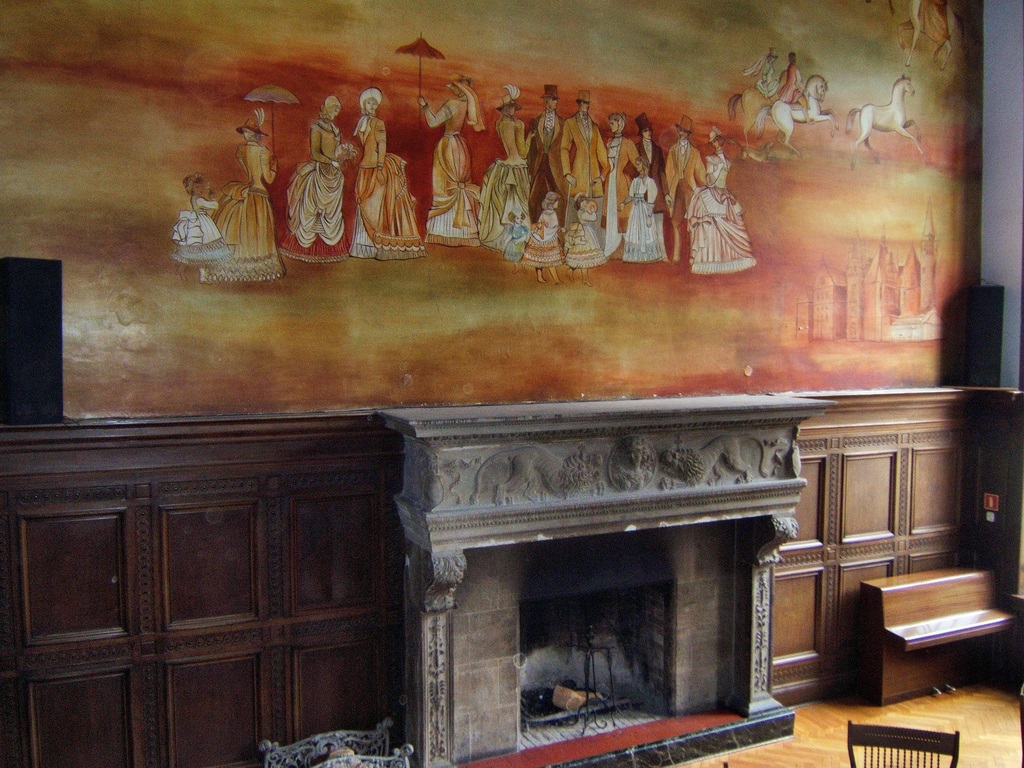
A fairytale castle with a history of its own
Po Polsce [In English], Podróze — Napisane przez: Anna Borsukiewicz. Opublikowano: 06/12/2011 1:00
From a distance it looks like Snow White’s castle or the castle of the Sleeping Beauty, who could be waiting for her prince in one of the ninety-nine towers piercing the sky with spires. Up close the multitude of decorative elements on the facades also makes a magical impression – the columns, ornamental window framings, reliefs and sculptures of animal and plant motifs, roscases, masks, heads, figures of fantastic creatures. On one of the towers, you can even spot a human skeleton.
The castle in Moszna (Opole province) is certainly one of the most original buildings that I have ever seen in Poland. The Neurosis Therapy Centre – as this is its official name – is not an encouraging name. Fortunately, there is no sanatorium-like atmosphere in the castle and the most attractive places are open for visiting with a guide.
What is left
Wandering around them you have to use your imagination, because there is nearly nothing left of the once splendid interiors. During World War II the castle did avoid destruction and its last owner, Gunter von Tiele-Winckler, abandoned it in the spring of 1945, but then the Soviet troops were accommodated there. At that time the elements of the interiors were stolen and devastated, with the equipment and the entire archive of the Tiele-Winckler family burned down in the yard.
The remains include mainly fixed decoration elements such as fireplaces, wainscoting, ornamental stuccos, coffered ceilings or book cabinets built into the wall of the old library. A collection of photographs that allows us to see the splendour of the previous interiors and a small display case with a few plates belonging to the Tiele-Winckler dinner set are all that is left of the „movable” property.
In the dining room – it continues to perform the same function, as the residents of the Neurosis Therapy Centre still board there – you can see the walls covered with white and pink marble facings, decorations made of white stucco and an ornamental grille over the entrance to the palm pavilion, where exotic plants have been collected.
In the high hall, which is now a cafe, all the fixed decoration elements have survived: the coffered ceiling, the stairs, the pillars and the arcaded portico. This is the place, as a guide told us, where visitors to the Tiele-Winckler family would wait to be greeted by the host. Sometimes they had to wait a long time to admire the magnificence of the interior with the decorative furniture, the carpets, the exquisite chandeliers and the stone fireplace. Today, only the latter remains in its original place. Above it, instead of an arras, hangs a contemporary painting showing the castle guests (or maybe the inhabitants?) in elegant nineteenth-century costumes.
In the other rooms, such as the castle gallery or the „master’s bedroom”, it is also worth seeing the original decoration elements. In the gallery – a coffered, partially glazed ceiling and decorative doors in marble portals, and also located above the door, a gilded loggia. The two-piece „master’s bedroom” (now the library of the sanatorium) used to be one of the representational rooms. The following remain intact: a Florentine portal from sandalwood and a mirror frame belonging together with the portal, a Munich stained-glass window with hunting motifs, the already mentioned book shelves and a desk.
The last of the visited rooms is the chapel, located underneath the „master’s bedroom”, made from greyish yellow sandstone, which now performs the function of a concert hall.

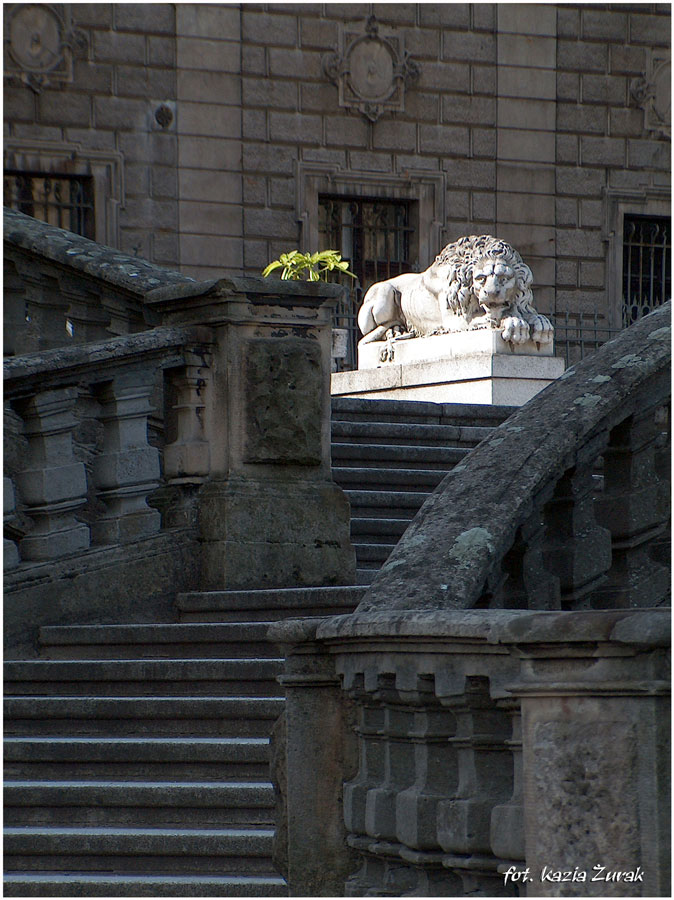
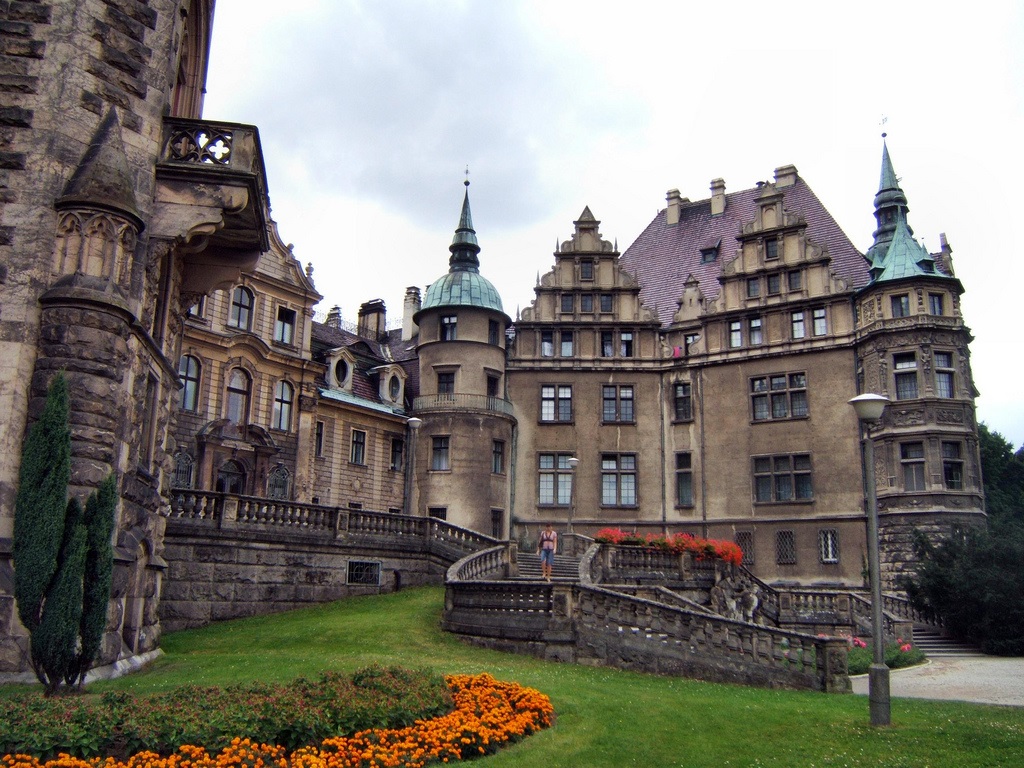

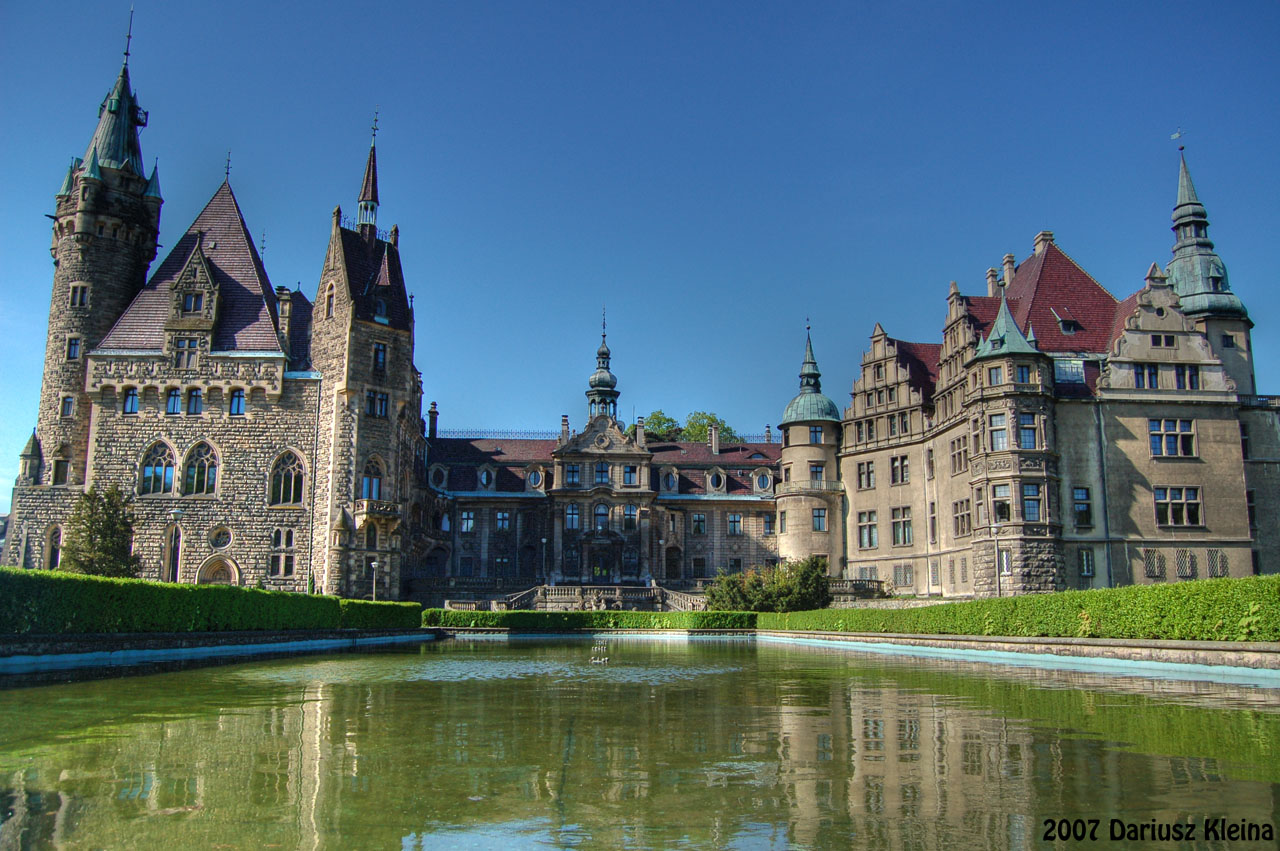
A mysterious park
In Moszna music is a form of therapy for the neurotic patients. Many other events are organized in the park, such as the concerts of Polish and German compositors and open air painting (the works painted are presented in the gallery of the castle). The annual spring „Festival of the blooming azaleas” is also rather well-known.
There is plenty of rhododendrons and other flowering shrubs as well as ancient trees in Moszna. The local landscape park is one of the largest and most beautiful parks of this kind in Silesia. Wandering around it (once you could also swim around, because the park canals and the surrounding ponds were a part of a water system connected with a haven next to the floodgate besides the castle) you can admire this fantastic, fabulous building from a distance.
From miner to earl
It is worth knowing the history of the castle, the remarkable story of Moszna and the Tiele-Winckler family even briefly, because it is fascinating indeed. Moszna was mentioned as a village as early as in the Middle Ages, reportedly it belonged to the Templars, then changed owners several times and eventually the property was bought in 1866 by Hubert von Tiele-Winckler. His son, Franz Hubert, after the fire of the local baroque palace decided to build a family mansion in Moszna. Under his personal supervision in the years 1896-1913 a picturesque, eclectic building came to existence – the castle with 365 rooms and 99 towers and turrets. Its surface area is 7 thousand metres square and its volume is 65 thousand metres cube. The residence was meant to show the power of the family and its aristocratic aspirations. The German Emperor Wilhelm II, who visited Moszna twice, granted Franz von Tiele-Wincler a hereditary earldom.
In fact the family had no aristocratic roots. Its ancestor, Franz Xavier Winckler was an ordinary miner in the first half of the 19th C. He was a very talented man, who after graduating in Tarnowskie Góry became a shift foreman, and then a manager of a mine called „Maria”. Marrying the widow of the mine’s owner and Franz Winckler’s business activity not only made him a wealthy man but also granted him a knighthood. The family owed further increase in significance to the marriage of Valeska (daughter of Franz) with Lieutenant Hubert Gustaw von Tiele. At that time the families joined their names and crests and Moszna was bought as one of the family residences. As a curiosity it is worth noting that thanks to the efforts of Hubert von Tiele-Winckler the town of Katowice was granted city rights.
It is also worth mentioning that the castle in Moszna is being successively renovated over the years. The conservatory has already been renewed and a thorough roof repair is finished (more than 4700 m² of tiles and 1000 m² of copper have been replaced on the turrets). The Neurosis Therapy Centre located in the building is to be transferred to a new pavilion nearby, and the castle is to become a luxurious hotel.
For visitors
The castle in Moszna can be visited throughout the whole year, with the exception of Easter, Christmas,New Year’s Eve and New Year. In April, September and October tours take place between 2 and 3 pm (on weekdays) and at 2, 3 and 4 pm during days off from work. In May, June, July and August tourists enter the castle at 2, 3 and 4 pm (on weekdays), and on non-working days at 10, 11, 12 am and 2,3 and 4pm. At other periodss it is possible to visit only as organized groups after making a reservation by phone (numbers 77 466 84 18 84 63 77 466 and 77 466 96 79), by fax – No. 77 46684 00 or e-mail – address: marketing@moszna-zamek.pl.
Tours take place only with a guide, in groups of at least 10 people. An adult ticket costs 8 PLN, reduced (for pensioners and studying youth) – 5 PLN. To be admitted to the park you have to pay 5 PLN (normal ticket) or 3 PLN (reduced). Those who want to visit the castle must also purchase tickets for the park.
Moszna – a village in the Opole province, in the krapkowickie county, in the Strzeleczki commune.
GPS – N 50 ° 26’10 „E: 17 ° 46’21″
http://autopodroze.pl/bez-kategorii/a-fairytale-castle-with-a-history-of-its-own/




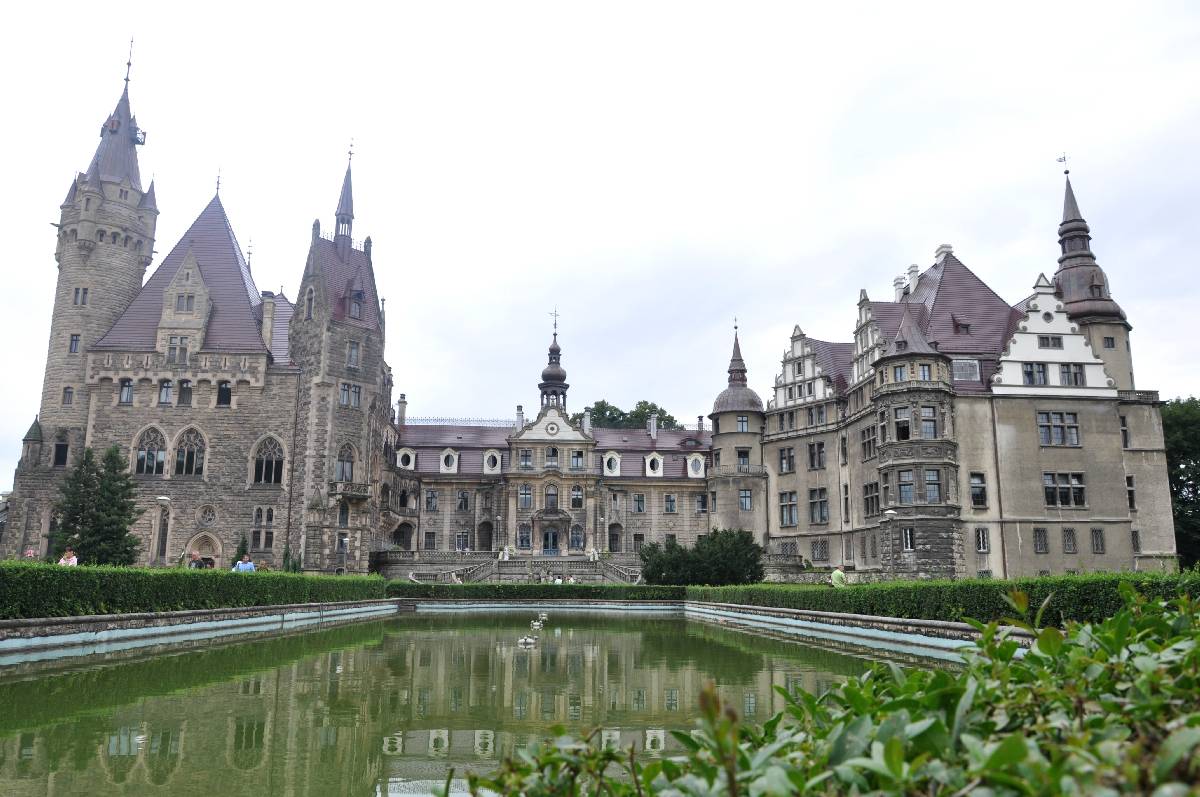
The castle in Moszna is one of the best known monuments in the western part of Upper Silesia. The history of this building begins in the 17th century, although old cellars were found in the gardens during excavations carried out at the beginning of the 20th century. Some of the investigators, including H. Barthel, claimed that those cellars could have been remnants of a presumed Templar castle, but their theory has never been proved. After World War II, further excavations discovered a medieval palisade.
The central part of the castle is an old baroque palace which was partially destroyed by fire on the night of April 2, 1896 and was reconstructed in the same year in its original form by Franz Hubert von Tiele-Winckler (the son of Hubert von Tiele-Winckler). The reconstruction works involved an extension of the residence. The eastern Neogothic-styled wing of the building was built by 1900, along with an adjacent orangery. In 1912-1914, the western wing was built in the Neorenaissance style. The architectural form of the castle contains a wide variety of styles, thus it can be generally defined as eclectic. The height of the building, as well as its numerous turrets and spires, give the impression of verticalism.[1] The whole castle has exactly ninety-nine turrets. Inside, it contains 365 rooms with a total floorage of 7,000 sq. m. and a cubic capacity of about 65,000 m3.[2] The castle was twice visited by the German Emperor Wilhelm II. His participation in hunting during his stay at the castle was documented in a hand-written chronicle in 1911 as well as in the following year.[1]
The castle in Moszna was the residence of a Silesian family Tiele-Winckler who were industrial magnates, from 1866 until the spring of 1945 when they were forced to move to Germany and the castle was occupied by the Red Army. The period of the Soviet control caused significant damage to the castle's internal fittings in comparison to the minor damage caused by WWII.[1]
http://en.wikipedia.org/wiki/Moszna_Castle
http://pl.wikipedia.org/wiki/Moszna_(województwo_opolskie)
http://lugaresquever.blogspot.com.es/2010/07/moszna-polonia.html
http://panoramy.zbooy.pl/360/pan/moszna-zamek-kawiarnia-hdr/e
http://www.flickr.com/search/?w=98126384@N00&q=Moszna
http://www.flickr.com/photos/jolanta_gradowicz/tags/mosznacastle/
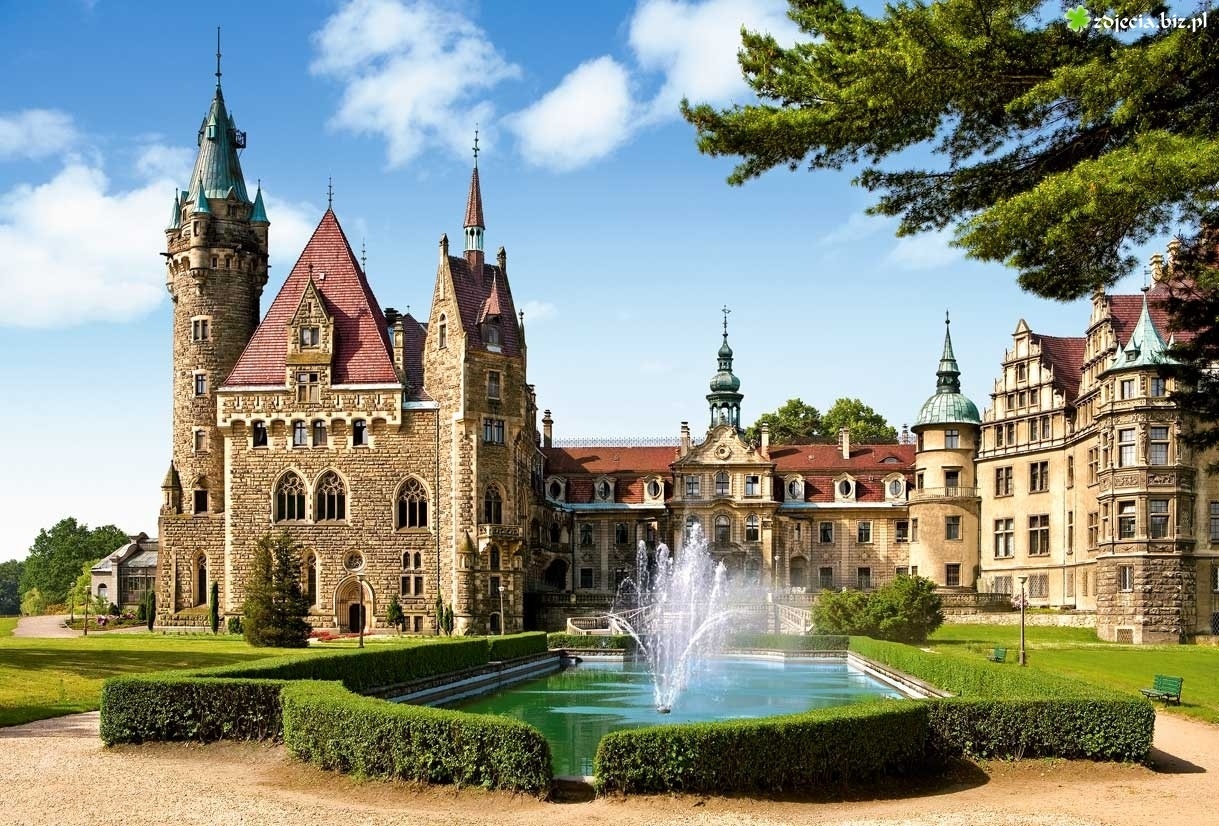
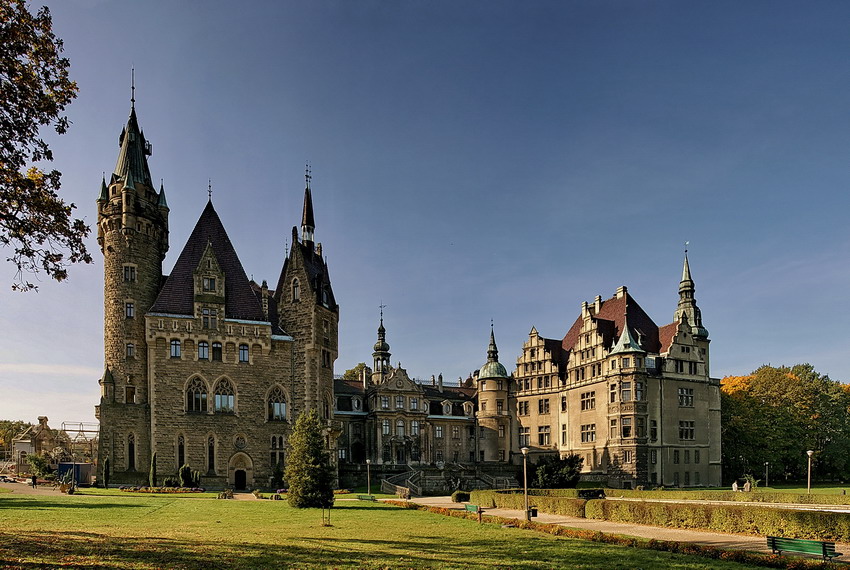
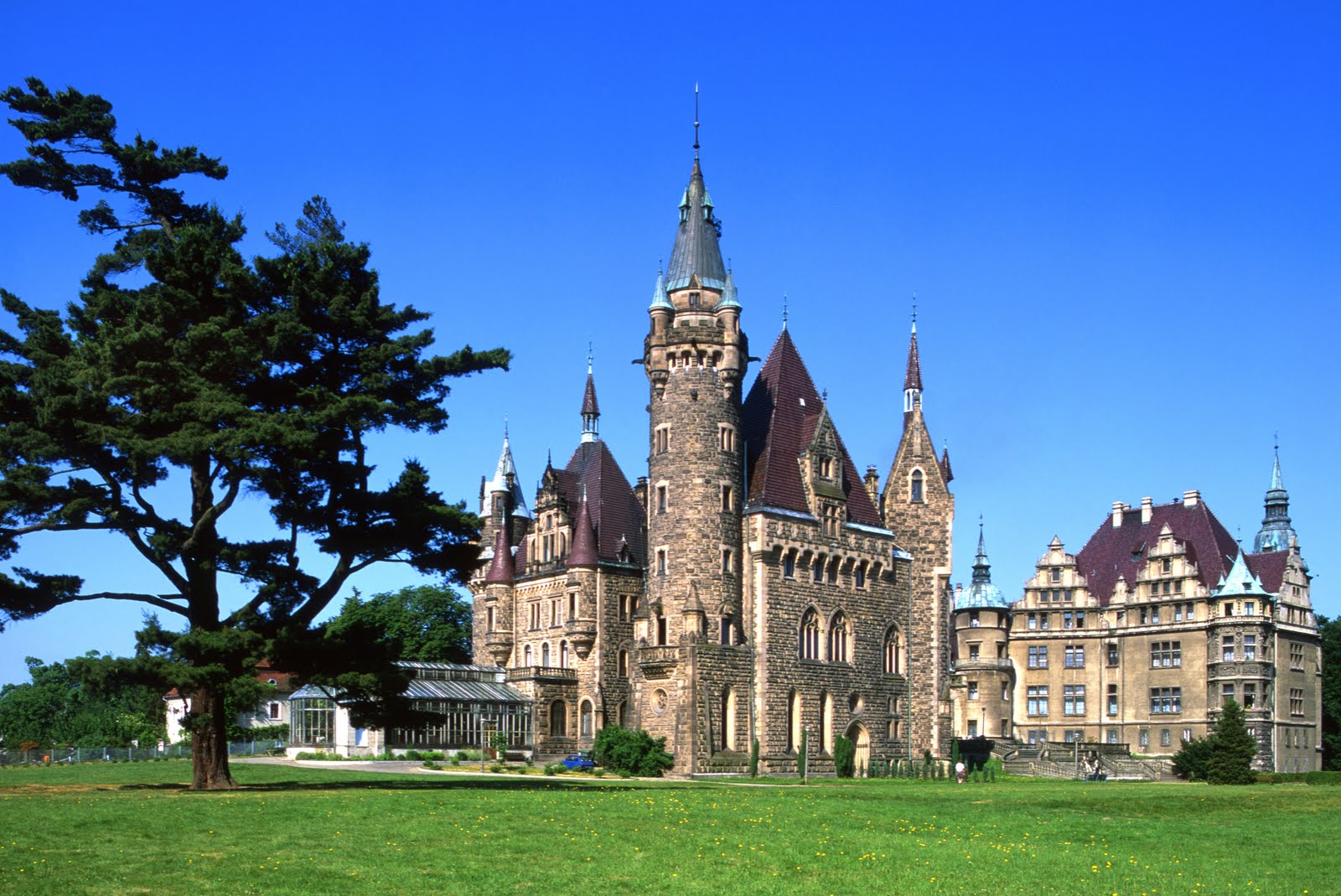
Vídeo:
Web recomendada: http://www.moszna-zamek.pl/
Contador: 13188
Inserción: 2013-06-17 14:31:36
Lugares a visitar en un radio de 100 km (en línea recta)
Mapa de los lugares a 100 km (en línea recta)
Mostrando Registros desde el 1 hasta el 0 de un total de 0
Visitas |
Más visitados Basílica de San Marcos 154471 Catedral de Notre Dame (París) 143787 Torre de Pisa 131209 Monte Saint-Michel 100342 Presa de las Tres Gargantas 80815 |
Incorporaciones |
Comentarios hazola Cúpula de la Roca gracias me... gera Buenos Aires las mejores fotos de la mejor ciudad del... Daniel M. - BRASIL San Francisco ... PEQUE Presa Chicoasén SERA QUE ALGUIEN ME PUEDE DAR MAS INFORMACIÓN DE ESTE PROYECTO ESTUDIO EN LA UNACH Y ES PARA UN... Mery Huaca Pucllana Muy interesante, muy buena la información y... |
 Tweet
Tweet


